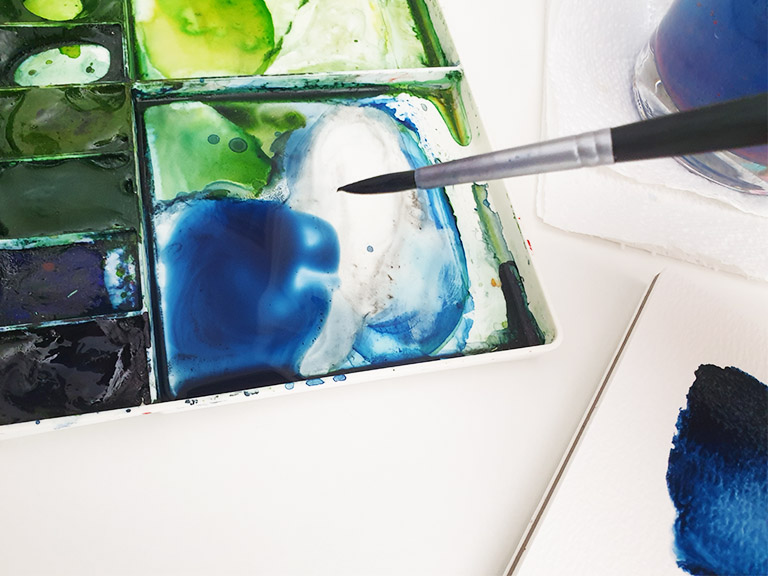Watercolour supplies are really expensive! Those tiny tubes of paint can be pricey, and don’t even get me started on the paper. I find that many artists, especially beginner painters, are so reluctant to waste supplies that they put off even opening them.
But supplies that aren’t being used are the biggest waste of all. So how can you get the most out of your supplies and make them last longer?
How to make watercolour paint last longer
Paint is one of the most expensive supplies for watercolour painting. The steps here will depend on whether you have paint in little plastic pans, or in liquid form (tubes or bottles).
Store paint properly
Keep your watercolour paint in a cool, dry place and make sure the lids are tightly closed to prevent evaporation and keep the paint from drying out. If you have paint pans, ensure they’re in a palette with a closed lid to stop them drying and cracking.
Only squeeze out a tiny bit of paint
If you’re using tube paint or liquid watercolours, a little will go a long way! Don’t squeeze out a large amount – a tiny smudge should be enough. This gets easier with practice, but remember than you can always get more paint later, but you can’t put it back in the tube once it’s out.
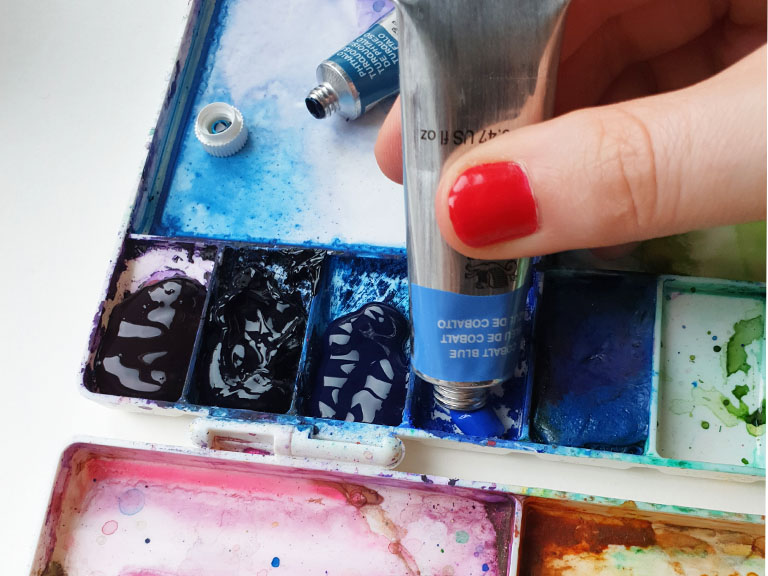
Rehydrate old paint on your palette
I never clean my palette – I like to leave the paint mixtures to dry and then rehydrate them for using later. You can just add water to reactive the puddles and you’re all set! It’s also a great way to create complex colour mixes, by simply mixing new paint on top of older, dried paint.
Mix colours carefully
Take your time when mixing colours – if you mix up a big batch of paint and it’s the wrong colour, you’ll use even more paint fixing it. Keep old scraps of paper near your palette for testing colours as you go – it’s hard to see the exact colour on the palette sometimes.
Use a palette with wells
A palette with separate wells for your colours will allow you to keep different colours separate and prevent cross-contamination.
Don’t overwork the paint
Overworking the paint by adding too many colours and layers can lead to muddy colours and loss of detail. Instead, work in layers, allowing each one to dry fully before moving on, to build up colour and texture while keeping the luminous finish.
Use plenty of water
Water is one of the main components in watercolour painting. You can get away with a lot of water and only a touch of paint – it simply lightens the colour. To practice this, try creating a value scale – create a small square of your paint neat, then add water to your mix and paint another square. Keeping adding water and painting squares until you get a value scale – see how far your paints can go?
Bonus: How much water to use in watercolour painting
Invest in high-quality paint
High-quality, artist grade watercolour paint will have better pigments and will provide more intense colours and better tinting strength. While more expensive initially, it lasts much longer than cheaper paints, and you need less of it to create rich, bold colours.
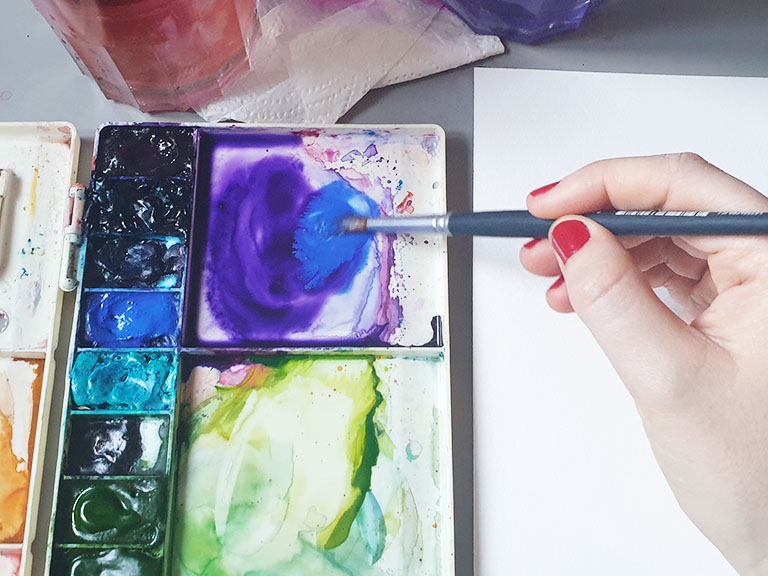
How to make watercolour paper last longer
Paper is probably the most expensive element of watercolour painting, especially the cotton papers from premium brands.
Store watercolour paper properly
To prevent watercolour paper from going off, it’s important to store it in a cool, dry place away from light and moisture, and to protect it from environmental pollutants. You can also store your paper in a plastic bag or container to help prevent exposure to moisture, light, and pollutants. By taking care of your watercolour paper, you can extend its lifespan and ensure that your artwork remains vibrant and of high quality for many years to come.
Cut up your paper into smaller pieces
If you’re overwhelmed by a large blank canvas, try cutting up your paper to create smaller paintings. It’s less intimidating, meaning you’re more likely to get started, and it means you can create several paintings from a single sheet.
Paint on the back of your watercolour paper
This is something lots of artists won’t tell you, but I can barely tell the difference between the front and back of most watercolour papers. I often flip the paper over and paint on the back – it’s double the paper that way! Unless you’re planning to sell the piece, flip it over and paint on both sides.
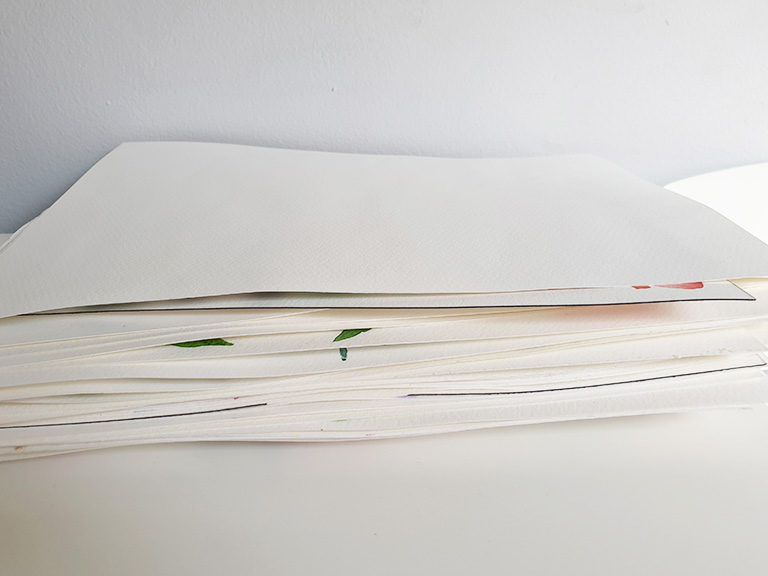
Practice on cheaper paper
Use cheaper watercolour paper, or even cartridge or sketchbook paper, for practicing, sketches and warm-ups. This makes your better-quality supplies last longer.
Tape down your paper
Use masking tape to hold your paper flat so it doesn’t buckle or create puddles and hard edges as you work. Let it dry fully while taped and then carefully peel up once it’s dry. To avoid ripping the paper, pull the masking tape up slowly and pull it back in a diagonal so it detaches from the paper properly.
Protect your paintings
Once your paintings are complete, make sure to protect them by matting and framing, or by storing them somewhere cool, dry and out of direct sunlight. If you do hang pictures in the sunlight, they will fade over time.
Use good quality paper
High-quality watercolour paper does make a big difference to watercolour painting. Cotton papers take longer to dry, giving you time to get smooth blending and creative effects. They also make the paints appear more vibrant. If you’re getting serious about painting with watercolour, upgrading to premium paper is worth the investment.
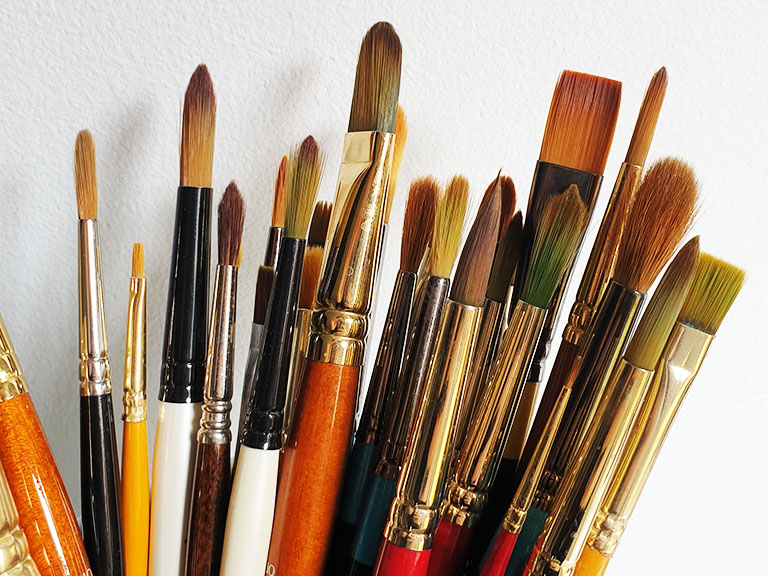
How to make watercolour brushes last longer
While many watercolour brushes are cheap compared to other supplies, they’re also really delicate and prone to bending or being damaged. Here’s how to extend their lifespan.
Never leave brushes standing in water
Once you’ve rinsed your brush, take it out of the water jar and lay it flat on the table, on a paper towel. This stops the bristles getting bent and damaged in the water jar.
Always clean and reshape brushes
After you’re done painting, clean your brushes and reshape the tips. This is super important for watercolour painting because the brushes are so delicate compared to mediums like acrylic. Use your fingertips to shape the bristles back into a point and lay out flat to dry.
Never use masking fluid with your favourite brushes
Masking fluid is a liquid latex, and it’s great for creative painting effects but it absolutely ruins brushes! Use cheap brushes or buy special ones with silicone tips for applying masking fluid.
By following these tips, you’ll get the most out of your watercolour supplies and make them last longer.
The final word – please use your supplies!
I know this whole article has been about making the most of your supplies, and I do believe in making expensive things last longer. But please don’t just leave your supplies sitting in a drawer – that’s the biggest waste of all!
Do not worry, EVER, that making a bad painting is a waste of supplies – it’s not. Even if you don’t love how it turns out, you’re still using your supplies in the right way. Paint for the process, not the results, and enjoy carving out some time to be creative and make something with your hands.
If you had fun, learned something, and created with joy, then your supplies have been used and appreciated, and that’s the right way to use them! Go forth and paint more, not less!
How to get started with watercolour
Download my free watercolour supply guide
Feeling overwhelmed and confused by watercolour paints, papers and brushes? Download my free guide filled with insider info, including a list of good supplies for every budget, and my complete supply list!
